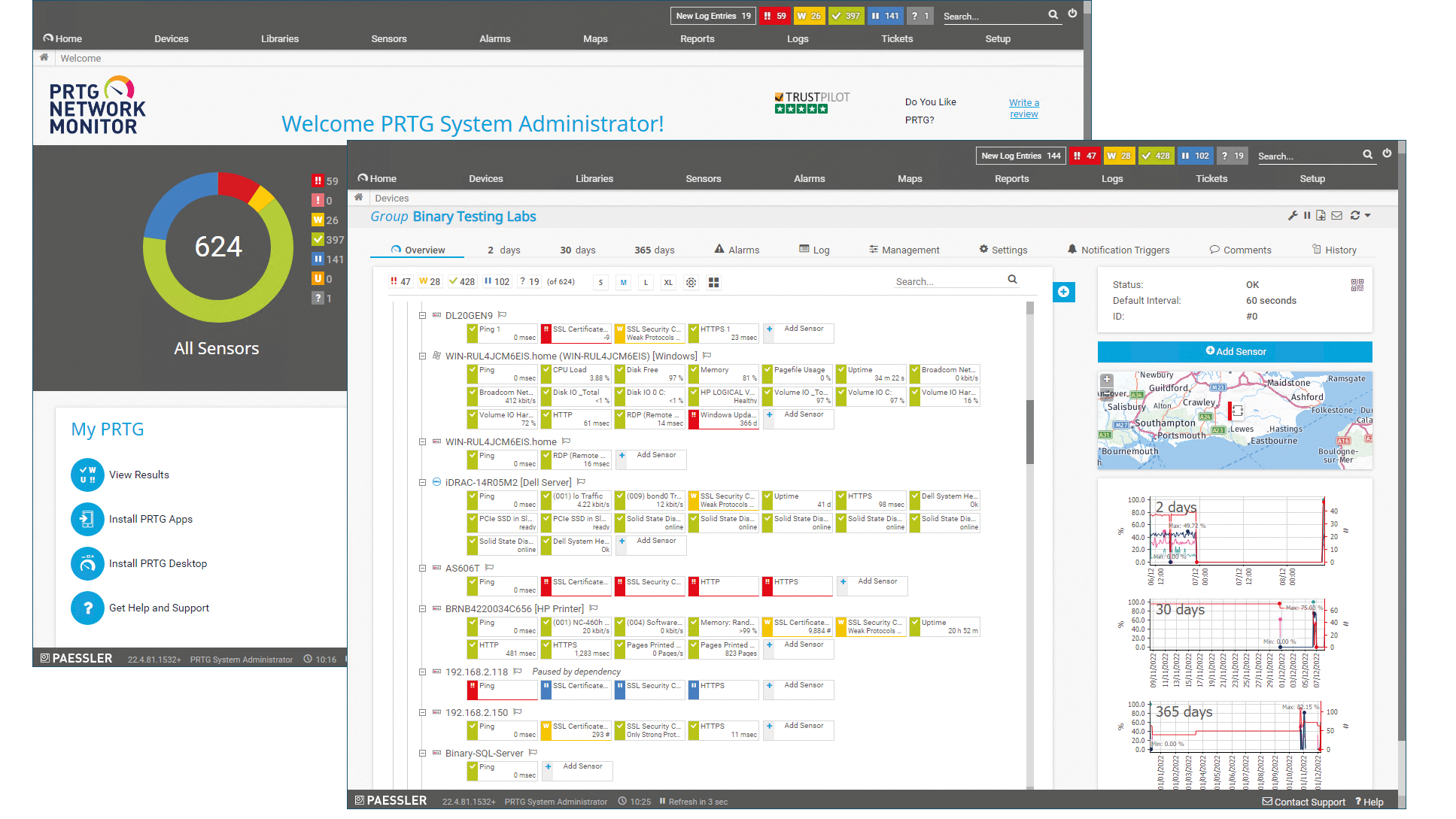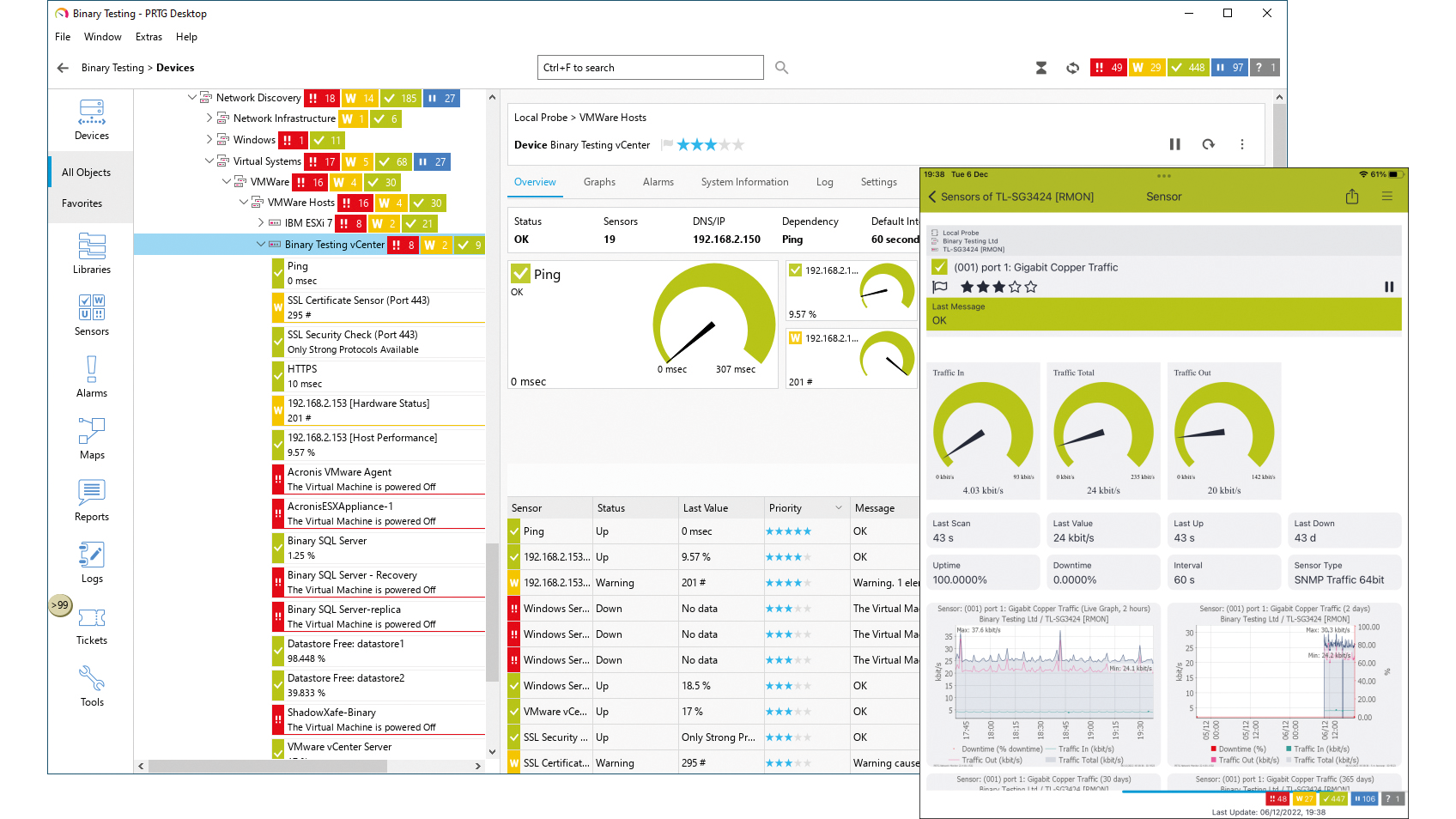Paessler PRTG Network Monitor 22.4 review: Extremely versatile network monitoring
With all sensors included in the price, PRTG is a great choice for SMBs that want the big network picture


-
+
Great value
-
+
Price includes virtualisation hosts
-
+
Highly versatile

Paessler's PRTG network monitor is probably one of the most versatile network monitoring products on the market thanks to its simple sensor-based licensing. Just choose the sensor pack you require and it can be assigned to anything on the network you want PRTG to keep a close eye on. And when we say anything, we mean it. The PRTG network monitor 22.4 on review currently offers 284 different types of sensor covering almost every type of network device, server, workstation, hardware component, service and business application.
Value looks even better, since the price includes sensors for monitoring VMware, Hyper-V, Citrix XenServer and Nutanix virtualisation hosts – features some competing vendors charge extra for. Even better, higher-level functions such as NetFlow, sFlow and jFlow monitoring are included as well.
With a perpetual 1,000-sensor licence costing €2,499, PRTG is good value, but if you don't want to incur the extra cost of a host system, Paessler can run it in the cloud for you. A yearly hosted 1,000-sensor licence costs €2,399 and you can monitor your local networks by installing remote probes in them.
Either way, you'll need to keep a close eye on sensor usage. During its first discovery, PRTG assigns the most appropriate ones to each device and they can get used up very quickly. For example, a 24-port TP-Link gigabit switch was awarded 47, our VMware ESXi 7 host received 31 and a Windows Server 2019 Hyper-V host slurped up 48 more.
Fortunately, the PRTG web console home page provides a complete summary showing the total number of sensors in use. If you have devices no longer on the network or components you don't want to monitor, you can delete them and return unused ones to the sensor pool for use elsewhere.

PRTG's main device view is capable of presenting a huge amount of information that can be neatly organised into hierarchical groupings. You can use these to represent things such as network locations, sets of application servers, cloud services, virtualisation hosts and so on. When devices are moved to other groups they inherit settings such as discovery schedules and login credentials from the parent group, or they can have their own settings.
Network pain points are easy to spot as each sensor is assigned a colour showing if they are up, down, paused or in a warning state. Plus, PRTG provides plenty of alerting methods including email, SMS, Syslog, Slack and Microsoft Teams. Clicking on any device pulls up a complete overview and activity graphs of all its associated sensors.
Sign up today and you will receive a free copy of our Future Focus 2025 report - the leading guidance on AI, cybersecurity and other IT challenges as per 700+ senior executives
You can drill down deeper into selected sensors and see activity summaries, live views and details of what's occurred over the past 48 hours, week, month or year. It's easy to spot the busiest devices from the Top 10 sensor page and you can use PRTG's libraries to load groups of sensor data for comparison.
Paessler provides pre-configured libraries for views such as CPU, memory and network interfaces, and you can easily create custom libraries for more specific activities. PRTG can be remotely monitored from a web browser or you can use Paessler's slick Windows and macOS desktop apps, which provide the same features and just as much information. Mobile support is simply the best as the free Android and iOS apps can remotely access the PRTG server, display all sensor data and receive alerts.
PRTG Network Monitor is a great choice for SMBs and the ability to assign sensors to any device you want makes it extremely versatile. It provides lots of informative consoles and everything is included in the price so you don't need to concern yourself with optional modules.
Paessler PRTG Network Monitor 22.4 requirements: Core Server and Probe: Windows 10 Server 2012 R2 upwards
Dave is an IT consultant and freelance journalist specialising in hands-on reviews of computer networking products covering all market sectors from small businesses to enterprises. Founder of Binary Testing Ltd – the UK’s premier independent network testing laboratory - Dave has over 45 years of experience in the IT industry.
Dave has produced many thousands of in-depth business networking product reviews from his lab which have been reproduced globally. Writing for ITPro and its sister title, PC Pro, he covers all areas of business IT infrastructure, including servers, storage, network security, data protection, cloud, infrastructure and services.
-
 Google is scrapping its dark web report feature — here's everything you need to know and some alternative options
Google is scrapping its dark web report feature — here's everything you need to know and some alternative optionsNews Google said while the dark web report feature offered “general information”, the tool didn’t provide “helpful next steps” for users potentially impacted by a breach.
By Emma Woollacott Published
-
 AI doesn’t mean your developers are obsolete — if anything you’re probably going to need bigger teams
AI doesn’t mean your developers are obsolete — if anything you’re probably going to need bigger teamsAnalysis Software developers may be forgiven for worrying about their jobs in 2025, but the end result of AI adoption will probably be larger teams, not an onslaught of job cuts.
By Ross Kelly Published
-
 JetBrains is mothballing its Fleet IDE service — here’s what developers need to know
JetBrains is mothballing its Fleet IDE service — here’s what developers need to knowNews The Fleet IDE platform will be discontinued later this month and updates will stop
By Ross Kelly Published
